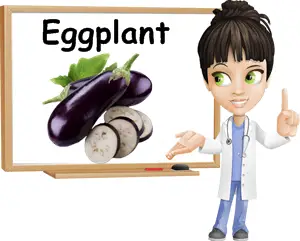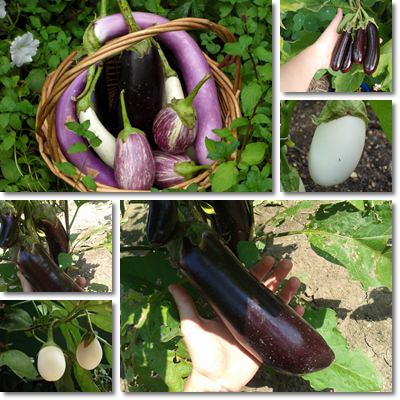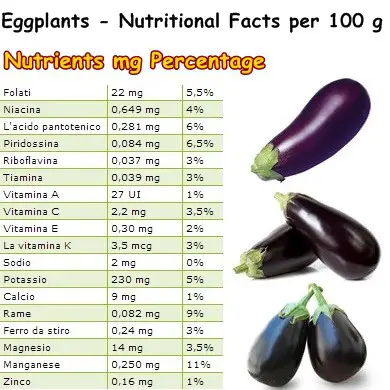A member of the nightshade family, the eggplant or aubergine (Solanum melongena) is a beautiful as well as wonderfully healthy addition to any diet. Both delicious and dainty culinary vegetables, they come in a variety of gorgeous colors, the most common being deep-purple and purple-black. Throughout Asia however, white and yellow eggplant varieties are extensively cultivated, while in other parts smaller yellow, green, pink, light purple or red violet cultivars are preferred.
Related to both tomatoes and potatoes, eggplants hold an honorable place in many cuisines and are wholeheartedly recommended for consumption because of their good nutritional value and antioxidant content. An interesting fact about eggplants is they are botanical berries, so fruit, but culinary vegetables and are in season roughly from August to October. The plant itself looks somewhat similar to the tomato plant in the sense that it grows several feet vertically and the eggplant is suspended from a vine just like the tomato is suspended from the tomato plant. Another interesting fact is the vegetable will take in quite a lot of fat and flavors during cooking. Also, eggplants are a common allergen, more likely in those with a tendency towards food sensitivities, intolerance or allergies. The seeds contain alkaloid compounds with mild stimulating properties.

What do eggplants look like?
There are several different types of eggplant. Some produce relatively small, egg-shaped fruit that fit in the palm of your hand. Other varieties yield large, elongated, slightly curved fruits, fuller towards the bottom, looking a lot like squash or crescent-shaped.
There are also some slim and long eggplant varieties and others that are as small as a finger. For the most part, the skin of the fruit is glossy, shiny and smooth, but tough. Eggplants before ripening are light green while ripe ones are purple-black, dark purple, red violet, pink-violet, yellow, white, gradient or striped (white and pink, white and red violet, different shades of green). Some varieties remain green even when ripe.
Flesh is creamy white, slightly spongy but, firm and fresh. Each plant has several tiny, somewhat flat and bean-shaped, light-colored seeds.
What do eggplants taste like?
Eggplants have little flavor. They taste somewhat like squash or gourds and a bit like cucumber, mild, fresh and slightly bitter. The larger the vegetable, the more bitter its taste (although not very bitter overall). The more tender it is, the less bitter (it may even have a slight sweet after-flavor).
The creamy white pulp is firm, but soft and moist, sometimes even slightly crisp (but not as crisp as cucumbers, for example). Skin is tough and may taste anywhere from bitter to bland with a barely there bitter aftertaste.
Because of its taste, it’s peeled off and discarded before cooking. The pulp, seeds and skin are all edible and the vegetable is light and easy on the stomach.
See also: Can You Eat Raw Eggplant?
Tips on how to cook eggplant
Peeling the skin reduces bitterness. Salting the pulp reduces its absorbent quality so it takes in less cooking fat. If recipes call for grated eggplant, it is advised to drain the pulp to avoid sogginess. Regardless of the variety, eggplants have a pleasant, slightly bitter taste and a spongy-textured pulp which softens significantly when cooked, acquiring a sophisticated, rich flavor from the other ingredients and spices it’s paired with.
How to choose good eggplant
Because they spoil quickly, a great way to tell if they’re not fresh is by the texture of the pulp: the spongier and drier the pulp, the older the vegetable. Also, it’s recommended to choose eggplants with a glossy, smooth skin and no blemishes or spots. Avoid wrinkled, dull-looking vegetables with brown spots. How to avoid old eggplants? Press the skin gently with the finger: if it bounces back, it’s fresh; if the dent remains, it’s old.

Is eggplant good for you?
In addition to a variety of vitamins and minerals, the glossy purple, red violet, pink or white vegetables are rich in phytochemicals with potent antioxidant effects. For instance, eggplants contain phenolic compounds such as caffeic acid and chlorogenic acid, as well as flavonoids like nasunin. Caffeic acid is a phenol with amazing anti-inflammatory and antioxidant properties that is shown to inhibit cancer cell proliferation. Chlorogenic acid is an amazing hepatoprotective and studies suggest it is incredibly efficient in stopping the multiplication of tumor cells in liver and colon cancers. Other amazing health benefits of chlorogenic acid include antimicrobial, (LDL) cholesterol-lowering and antiviral properties.
The flavonoid called nasunin is mostly found in the skin of the vegetable. Studies focused on the health benefits of nasunin show that it is a powerful antioxidant which efficiently protects cell membranes from the oxidative effects of free radicals. Cell membranes are basically made up of lipids (or fat), which are directly responsible for the protection of cells. Studies on animals have shown that the nasunin found in eggplants enhanced the resistance of brain cell membranes against free radical damage. Dark purple or black eggplants are richest in anthocyanin antioxidant pigments like nasunin, followed by lighter colored red-violet, pink and red striped varieties.

Overall, the natural compounds found in eggplants hold important antioxidant properties as well as exhibit antimicrobial and antifungal activity. If you take a look at the nutritional table above, you will see that the vegetable also lists a number of vitamins and minerals as well. Important B-group vitamins and minerals such as manganese, potassium, magnesium and phosphorus are all found in decent quantities in eggplants, followed by small amounts of zinc, iron and calcium and vitamins C, E and K.
Potassium reduces high blood pressure by regulating high sodium levels in the blood, while magnesium helps integrate calcium in bones as well as contributes to mental health and regulates cardiac activity. Both minerals are good for arrhythmia and hypertension, although in amounts far greater than what eggplants contain. Manganese, the most significant antioxidant-nutrient in eggplants, protects against oxidative stress from free radicals.
What are the benefits of Eggplants?
Here is a list of potential eggplant benefits:
- Low in calories (25 kcal/100 g of eggplant), promotes weight loss.
- Relieves constipation thanks to a good fiber content (3 g of dietary fiber/100 g of whole vegetable).
- Good food to eat if you have hemorrhoids, thanks to the fiber content.
- Provides antioxidant benefits, especially if eaten with skin.
- Good for brain as it is a good source of B vitamins (B1, B2, B3, B5, B6 and B9).
- Helps boost energy levels and combat fatigue due to good B vitamin profile.
- Possible benefits for skin and hair as a result of B vitamins profile and vitamins E and C. Deficiencies of the B vitamin complex cause side effects such as dry, scaly skin, eczema, seborrheic dermatitis or acne and brittle hair. Vitamin E helps skin retain moisture, while vitamin C is good for wrinkles.
- Minor cardiovascular benefits: better blood pressure from the potassium, magnesium and vitamin B1, possible benefits for cholesterol from antioxidants and fiber.
- Potentially good for diabetes due to low calorie content which promotes weight loss and the combined effects of other micro and macronutrients.
- Tonic properties restoring general well-being due to a good vitamin and mineral content.
Side effects and contraindications of Eggplants
Allergic reactions
If you are eating eggplant for the first time, be careful because it hold allergenic potential. Allergy may be mild, with symptoms such as itchy mouth and throat, burning sensation in the mouth or back of the throat, rashes, stomach upset, possibly diarrhea and indigestion or headaches. Severe allergic reactions to eggplant can cause breathing difficulties, laryngospasms, cardiovascular symptoms and anaphylactic shock. It’s important to seek medical help is you feel sick after eating eggplants. Eggplant flower pollen can also trigger allergic reactions.
Sensitivity or intolerance
People with overactive immune systems are likely to exhibit adverse reactions to multiple foods or other elements like pollen or dust mites. Eggplants are one food that has the potential to trigger hypersensitivity reactions in those that are genetically predisposed.
Eggplants in pregnancy
Despite having a good folate (vitamin B9 content) which promotes normal development of babies in the womb, the vegetables do not otherwise hold many benefits for pregnant women. Actually, because of their allergenic potential and the fact that they contain solanine with mildly toxic properties, pregnant women are advised not to eat too many eggplants during pregnancy.
Eggplant recipes: ideas
Eggplant salad, dip or spread is a popular eggplant dish made from eggplants roasted in skin. After baking, the softened pulp is removed, pureed and mixed with chopped onions and mayonnaise, to spread on bread or bruschetta, with or without fresh tomatoes. Ratatouille is a famous French stew which employs eggplant, tomatoes, zucchini, bell peppers, onions, various herb mixes and garlic. The vegetables can be cooked separately so that they keep most of their original flavors or added to the stew in a certain order that accounts for their different cooking times.
Italian eggplant parmesan is a real Italian dish made with sliced eggplant deep fried in oil in a pan then layered with tomato sauce and Parmesan cheese (Parmigiano Reggiano) or mozzarella and baked (no breading). Other popular recipes including the vegetable are pasta, stuffed eggplant, filled with meat or rice and other vegetables and baked or eggplant milanese made from eggplant slices rolled in flour, egg and bread crumbs or egg and flour or bread crumbs and fried.
